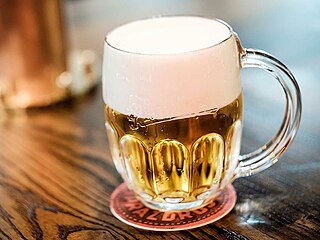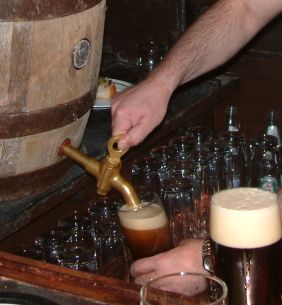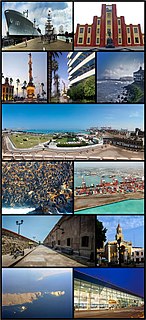
Pilsner is a type of pale lager. It takes its name from the Czech city of Pilsen, where it was first produced in 1842 by Bavarian brewer Josef Groll from local ingredients. The world’s first blond lager, the original Pilsner Urquell, is still produced there today.

Pilsner Urquell, is a Czech lager brewed by the Pilsner Urquell Brewery in Plzeň (Pilsen), Czech Republic. Pilsner Urquell is the world’s first blond or pale lager, and its popularity meant it was much copied, and many of these copies are named pils, pilsner or pilsener. It is hopped with Saaz hops, named after a town in West Bohemia, a noble hop variety which is a key element in its flavour profile, as is the use of soft water and fire-brewing. It is available in 330 ml, 355 ml and 500 ml aluminium cans and green or brown bottles.

Beer in Mexico has a long history. While Mesoamerican cultures knew of fermented alcoholic beverages, including a corn beer, long before the Spanish conquest, European style beer brewed with barley was introduced with the Spanish soon after Hernán Cortés’s arrival. Production of this beer here was limited during the colonial period due to the lack of materials and severe restrictions and taxes placed on the product by Spanish authorities. After the Mexican War of Independence, these restrictions disappeared, and the industry was permitted to develop. Furthermore, the arrival of German immigrants and the short-lived empire of Austrian Maximilian I in the 19th century provided the impetus for the opening of many breweries in various parts of the country. By 1918, there were 36 brewing companies, but over the 20th century, the industry consolidated until today, only two corporations, Grupo Modelo and FEMSA control 90% of the Mexican beer market. This industry is one of the most prevalent in the country, with over 63% of the population buying one brand or another. Beer is also a major export for the country, with most going to the United States, but is available in over 150 countries worldwide.

Grupo Modelo is a large brewery in Mexico that exports beer to most countries of the world. Its export brands include Corona, Modelo, and Pacífico. Grupo Modelo also brews brands intended solely for the domestic Mexican market, Estrella ; and León and Montejo. Grupo Modelo has exclusive rights in Mexico for the import and distribution of beer produced by Anheuser-Busch. Until the 1960s, Grupo Modelo used red poppy flowers in its advertising, where almost any image it used had poppy flowers somewhere in the image.

Beer has a long history in what is now the Czech Republic, with brewing taking place in Břevnov Monastery in 993. The city of Brno had the right to brew beer from the 12th century while Plzeň and České Budějovice, had breweries in the 13th century.
San Miguel Brewery Inc. (SMB) is a subsidiary of San Miguel Corporation (SMC) and jointly owned with Kirin Holdings Co. Ltd. The company is the Philippines’ largest brewery with a market share of over 95% as of 2008. The company also operates in China and Southeast Asia.
Plzeňský Prazdroj, a. s. (pronounced [ˈpl̩zɛɲskiː ˈprazdroj a ɛs], known in English as the Pilsner Urquell Brewery, is a Czech brewery founded in 1842 and headquartered in Plzeň, Czech Republic. It was the first brewery to produce pale lager, branded as Pilsner Urquell; the popularity of Pilsner Urquell resulting in it being much copied so that more than two-thirds of the beer produced in the world today is pale lager, sometimes named pils, pilsner and pilsener after Pilsner Urguell. The brewery name, Pilsner Urquell, which can be roughly translated into English as "the original source at Pilsen", was adopted as a trademark in 1898. Pilsner Urquell is the largest beer producer in the Czech Republic and is also the largest exporter of beer abroad.
San Miguel Beer refers to San Miguel Pale Pilsen, a Filipino pale lager produced by San Miguel Brewery. Established in 1890 by the original San Miguel Brewery, it is the largest selling beer in the Philippines and Hong Kong. It is known in Chinese as 生力啤酒. San Miguel Beer was introduced in Spain by San Miguel Brewery in 1946. The Spanish rights were spun-off in 1953 by San Miguel Brewery and became an independent entity presently known as the Mahou-San Miguel Group.
Mahou San Miguel is a Spanish brewing company, founded in Madrid in 1890 under the name of Hijos de Casimiro Mahou, fabrica de hielo y cerveza.
SABMiller was one of the top five global brewing companies, and had a range of over 150 beers, including international beers such as Pilsner Urquell, and Miller Genuine Draft, and local ones such as Gambrinus and Castle Milk Stout.
Anheuser-Busch InBev SA/NV is the largest beer company in the world. It had 200 brands prior to the merger with SABMiller on October 10, 2016. The combined ABInBev/SAB Miller entity has approximately 400 beer brands as of January 2017.

Backus and Johnston is the largest brewery in Peru, part of Bavaria Brewery, which itself is part of the international SABMiller group. Its main brewery is located in the Ate District of Lima. Backus, as owner of almost all brands of beer available in Peru, enjoys a de facto monopoly over Peruvian beer consumption, although recently a lot of micro-breweries have sprung up and Anheuser-Busch InBev from Brazil is trying to challenge the monopoly with their Brahma brand. Besides beer, Backus also produces soft drinks and bottled water.
The beers of the Caribbean are unique to each island in the region, although many are variants of the same style. Each island generally brews its own unique pale lager, the occasional stout, and often a non-alcoholic malta beverage. Contract-brewing of international beers is also common, with Heineken Pilsener and Guinness Foreign Extra Stout being the most popular. The beers vary between the islands to suit the taste and the brewing method used.

The primary beer brewed and consumed in Chile is pale lager, though the country also has a tradition of brewing corn beer, known as chicha. Chile’s beer history has a strong German influence – some of the bigger beer producers are from the country’s southern lake district, a region populated by a great number of German immigrants during the 19th century. Chile also produces English ale-style craft beers while also developing its own craft beer identity.
Moritz is a brand of Spanish beer, with its headquarters on the Ronda Sant Antoni in Barcelona, Catalonia. Unlike its crosstown rival Damm, Moritz markets itself as the only beer brand in the world whose labeling is entirely in the Catalan language. The company was founded in 1856 by an Alsatian immigrant, Louis Moritz Trautmann. After ceasing production in 1978 due to the energy crises, the brand was relaunched in 2004 by Trautmann's descendants.
Beer in the Philippines is mainly produced by the two large breweries: San Miguel Corporation, which produces San Miguel Pale Pilsen, and Asia Brewery, the second-largest brewery in the country. These large producers are now being joined by a small but growing number of microbreweries opening up across the nation, including Juan Brew, Fat Pauly's in Iligan, Katipunan Craft Ales, Craftpoint, Great Islands Brewing in Manila, Bog's Brewery in Bacolod, Xavierbier brewing in Baguio at the tasting room Baguio Craft Brewery, Palaweño Brewery in Palawan, and Cebu Beer Factory in Cebu.
Compañía Cervecera de Nicaragua (CCN) is a Nicaraguan brewery based in Managua, Nicaragua.
This article discusses beer in Central America.

Costa Rica has a very strong beer industry centered on mass-produced Lagers. Imperial beer, produced by Florida Ice & Farm Co. is known and associated with Costa Rica all around the world.












